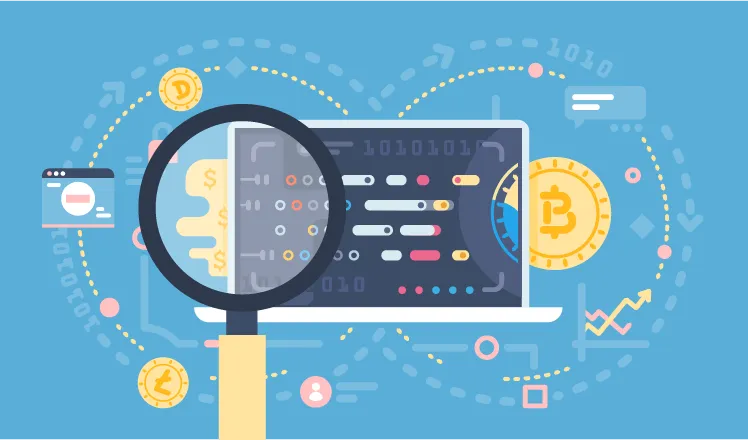
Few surveys indicate that only 1% of blockchain initiatives have made it to production, while 92% have failed for various reasons. Lack of QA standards and understanding the blockchain is a major factor.
With its promise of widespread consensus, a shared, distributed ledger, and smart contracts, blockchain development services have the potential to revolutionize the way businesses are run today. Because of these advancements, quality assurance in enterprises now has more dimensions and points of view to consider.
What is Blockchain from a Quality Assurance Perspective?
The original intent of blockchain was to provide a safe and reliable means of transacting digital currency online. Today, it is being put to use in a wide range of fields, processing a wide range of data types.
Current uses include encrypting patients’ digital health records for privacy reasons, categorizing transactions for faster or cheaper payment methods, and more.
First, let’s define blockchain testing and then discuss its potential quality assurance (QA) applications. To begin, QA experts can utilize blockchain to conduct digital transactions in a more protected and dependable setting. This is feasible because of the numerous forms of authentication used in cryptocurrency transactions.
The quality assurance industry can benefit from a blockchain development company and its services in a number of ways, one of which is by decreasing transaction fees and times. The decentralised, immutable record provided by blockchain technology also makes quality assurance services more open and accessible to customers. Having access to reliable blockchain QA testing services could determine a product’s fate in the marketplace.
Some of the numerous positive outcomes for the QA industry include the following:
Numerous Applications:
As a result of its new method to process transactions securely, blockchain technology has the potential to increase the reliability, efficiency, and effectiveness of a wide variety of businesses in the QA industry.
Security Importance:
Because blockchain technology necessitates the anonymity of every user and every transaction, the safety of all transactions conducted on this platform is greatly enhanced. In addition, blockchain uses encryption, making it a secure platform for a variety of operations.
Functionality
The technique relies on a practical blockchain testing framework to evaluate and ascertain whether or not a smart contract is viable.
Speed
Since time is money, employing blockchain technology has the added benefit of being a quicker and more efficient mechanism for processing transactions.
In order to begin testing a blockchain-based application, let’s have a look at the various validation and verification methods and pointers that will be required.
Ethical Responsibilities
Because they are about to test a system that establishes trust, where information is permanent and millions of dollars are at stake, testers have a responsibility to make a solemn vow that they will act ethically at all times.
Blockchain Knowledge
A solid understanding of blockchain is a must for quality assurance (testing) professionals. The difference between cryptographic techniques (data encryption and decryption) and consensus procedures should be clear to them (impact on performance and latency).
P2P Network Evaluation
The three-dimensional features of P2P systems—functionality, scalability, and volatility—need to be taken into account while developing a framework or test strategy.
Furthermore, we need to organize test scenarios for the subsequent network nodes:
1. Nodes:
- All nodes are operational.
- After data propagation, all nodes should have identical data.
- Data being sent from one node to another in real time.
- Allows for the incorporation of new hubs into the system.
- With this ability, you can delete individual network nodes.
- After data diffusion, the shared ledger is the same at all nodes.
- Validating node’s address.
- Collect and store each node’s address and secret key.
2. The Network Transmission of Data
If the data store is updated in chronological order, then all nodes will receive the data at the same time. Try hacking a single node’s data to see if it has any ripple effects on the network as a whole.Initiate data propagation from a further two nodes at the same time, and check each node’s data storage.
3. Network Safety and Fault Tolerance
- Put your knowledge of DDoS defenses and attacks to the test.
- Byzantine node simulation.
- Test the blockchain’s robustness by verifying its integrity once nodes that have rebooted or re-joined the network have caught up with the rest of the validating peers.
4. Types of Tested Networks
Public
Any developer is free to implement their own implementation of the ledger, and the results can be seen by the public.
Private
Access to the ledger and its contents are restricted to a small group of authorized users who have been granted access.
Write/Commit Access
When discussing a distributed ledger, the term “write/commit access” is used to describe who is allowed to make modifications to the ledger (e.g., who can add blocks to a blockchain).
Permissionless
In a permissionless (open) consensus system, everyone in principle is welcome to take part (in practice, however, often limited by resource requirements such as owning suitable hardware or cryptocurrency).
Permission(Closed)
Only authorized users have access to update the public ledger.
5. Test On-Chain Data
Data that is tested directly on the distributed ledger network is called “on-chain data.”
Test Off-Chain Data
Off-chain testing is the sixth Information: something done or transacted outside of the distributed ledger system.
6. Test Tokenization
It is the process of creating a digital representation of an existent asset that exists outside of the blockchain that can then be used on the blockchain itself to conduct a test.
7. Test Data-Diffusion
Diffusion of test data is the process by which and the audience for which information is shared in a decentralised ledger system.
Global
All nodes receive the same information simultaneously
Multi-Channel
Data is only shared with the parties participating in a given trade, a feature known as “multi-channel” (selective disclosure).
8. Gas Cost
Keeping an eye on gas prices is important since they must be paid in order to run programmes on Ethereum’s virtual machines. It is up to the QA team to design the tactics for tracking gas prices in order to spot problematic code.
9. Smart Contract Testing
The ever-evolving and growing blockchain infrastructure makes it difficult to test various use cases for smart contracts. For the purpose of testing, it is necessary to simulate all potential expected and unexpected scenarios for each contract, as well as test all conceivable permutations and combinations of business logic and the right triggering and execution of transactions and events.
10. Non-Functional Testing
Performance and latency can shift depending on the volume of transactions taking place on the network, therefore nonfunctional tests should account for this. The performance bottleneck is not only due to the consensus algorithm. Privacy in the ledger based on granular permissions and the efficacy of the network’s multi-layered security systems both need to be tested.
Blockchain Application Quality Assurance Testing Tools
The following resources are available to quality assurance testers for use in conducting network-based blockchain testing:
Gremlin
It is a flexible tool that can be used to simulate code changes and failures in the real world, enabling it to test the robustness of blockchains
Madt
Users with a Python background who want a testing tool for evaluating distributed systems will find what they need in Madt.
Truffle
The Truffle testing tool is enough for the needs of testers who wish to execute their test cases in Solidity or JavaScript.
Corda
The Corda Testing Tools open-source platform offers QA testers a complete suite of tools for rigorous testing. Particularly helpful when using IntelliJ with Java for integration and load testing.
MixByes Tank
Finally, MixByes Tank provides a streamlined interface mechanism for setting up a local blockchain testing cluster in a matter of minutes. It also allows them to draw attention to flaws in their test blockchain, which will help them understand the nature of their concerns.
Final Takeaways
One of the most game-changing developments of our time, blockchain is seeing increasing adoption on a daily basis. Numerous industries have found use for the blockchain ecosystem, with quality assurance testing being one of the more recent ones to do so.
This post should give readers some ideas for using blockchain technology to increase QA testing coverage. Even better, QA experts may take advantage of a wide variety of tools to conduct their tests, making blockchain testing that much more attractive.

